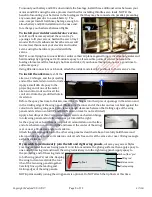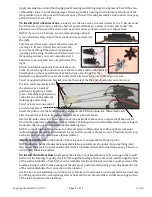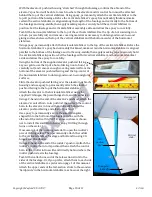
Copyright Maxford USA 2017
Page 3 of 12
S171201
III. SPECIAL FEATURES
•
Classic balsa and plywood construction.
•
All required openings are predrilled and/or precut.
•
Each aileron is separately operated by its own servo, giving customers the option of flaperons (if
permitted by customer’s radio system) and both aileron servos are safely located within the fuselage.
•
The wing is easily removed for transport to and from the lake for storage.
•
All major assemblies are preassembled and either precovered in Mylar or prepainted.
•
Designed for glow engines, but may be easily converted for electric power.
•
A supplied removable hatch gives customers a wide range of choices for using space inside the nose.
IV. IMPORTANT THINGS CUSTOMERS MUST KNOW BEFORE ASSEMBLING THIS ARF
Please read and follow all instructions carefully, even if you are an experienced builder. Any assembling,
testing or flying of this airplane is done entirely at your own risk. If you use a receiver battery to power
your radio system and you are using an electric power system, do not attempt to combine the output of
your radio’s battery with any battery-eliminator circuit.
V. STORAGE, FIELD SETUP & PREFLIGHT CHECKS
1.
Check the Mylar covering material’s joints and surfaces. If necessary, carefully use an iron on medium
heat to secure the edges and to tighten any loosened areas. Recheck and retighten from time to time; be
careful to not apply too much heat as you secure edges or tighten the Mylar. If any trim becomes
loosened, press it down and/or apply clear tape. Never apply heat to any trim or plastic part.
2.
Ensure the propellers are securely attached to your engines or motors and that they remain undamaged
and correctly balanced.
3.
To remove the wing:
a.
Remove the bolts securing the wing to the fuselage near the trailing edge of the wing.
b.
Slide the wing a few inches toward the tail, disconnect the servo extensions and glow-plug driver
wires if used, or motor wires if using an electric power system, then lift the wing fully away from the
fuselage. If desired for transport or storage, the wing panels may also be separated and the wing rod
may also be removed. Be careful to retain the removed wing attachment bolts, any optional Maxford
USA servo-extension safety clips you may have installed, and the wing rod if removed from the wing
panels.
4.
To reinstall the wing, reverse the above procedure:
a.
If the wing panels were separated, slide the wing panels onto the wing rod. Position the wing above
the fuselage and reconnect the servo extensions, optional Maxford USA servo-extension safety clips
and any other optional wiring (or motor wires if using an electric power system).
b.
Slide the wing forward and insert the carbon fiber ‘pins’ in the leading edge of the wing into the
former at the front of the wing saddle, then use the wing attachment bolts to firmly secure the wing
to the fuselage.
5.
Preflight checks:
a.
If any weight was added in the nose or tail to adjust the CG, ensure it remains secure.
b.
Double-check the condition and secure attachment of your propellers and batteries.
c.
Make certain all screws, clevises and other mechanical and electrical connections are secure.
(Do not attempt to fly with any damaged or frayed electrical or mechanical connection.)
d.
Double-check all control directions and the amounts of control throws.
e.
As with all radio-controlled model airplanes, this model must pass the radio range ground check
recommended by your radio’s manufacturer or you may not fly safely.
f.
Make it a habit to set your transmitter’s throttle control safely to minimum before turning ON your
transmitter and receiver and starting your engines or connecting your Lipo flight batteries.
g.
Setup and operate your radio-control and power systems according to their manufacturer’s
instructions and follow the guidelines offered by the Academy of Model Aeronautics, your local R/C
club, and concerned manufacturers, who all wish to help ensure your safe enjoyment of this hobby.






























